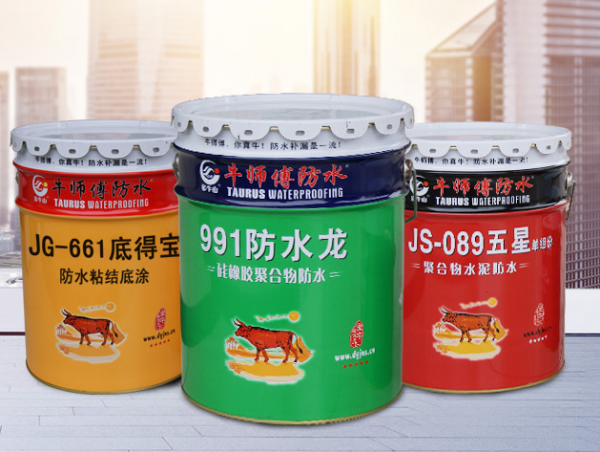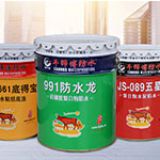Different buildings use different waterproof coatings?
2021-01-11 17:28:35
Waterproof roofing and basement waterproofing require different material properties, while bathroom waterproofing and wall waterproofing are more different. Slope roofs and roofs with complex shapes are also different, and materials should be selected carefully.
Building materials selection
1. Roofing waterproof layer
The roof waterproof layer is exposed to nature, exposed to hot sunlight, strong winds, rain and snow erosion, severe cold and heat temperature, repeated expansion and contraction of the temperature difference between day and night, without good material properties and good protection measures. It is difficult to achieve the required durability.
Therefore, a waterproof material with high tensile strength, high elongation and good aging resistance should be selected. Such as polyester tire polymer modified bitumen coil, EPDM rubber coil, P-type PVC coil (welded seam), one-component polyurethane coating (plus protective layer).
2. Wall waterproof
The reason why the wall leaks is that the current wall is too thin, mostly made of light block masonry, with a large number of internal and external joints, and the joints between doors and windows and the wall are not tightly sealed, and rainwater seeps through the joints. Coiled materials can not be used for wall waterproofing, only paint, and combined with exterior decoration materials. Only sealing paste can solve the problem of window installation seams.
3. Waterproofing of underground buildings
The underground waterproof layer is soaked in water or very moist soil for many years, and the waterproof material must be water resistant. The roll material made of perishable carcass cannot be used. The waterproof layer of the bottom plate should be thick and have a certain ability to resist punctures. It is best to laminate 6mm~8mm thick. If synthetic polymer coils are used, it is best to heat weld the seams. For those who use adhesive to join the seams, the glue should be excellent in water resistance, otherwise the best coils cannot be used. Use waterproof coatings with caution. The thickness is 2.5mm when used alone, and 2mm when used in combination with the coil.
4. Toilet waterproof
There are three characteristics of bathroom waterproofing. First, it is not affected by the natural climate, the temperature changes little, and the elongation rate of the material is not high; the second is the small area, the yin and yang corners are many, and the floor slab is more pipes; the third is the tile on the waterproof layer of the wall, and the adhesion The binding agent has good affinity. According to the above three characteristics, coiled materials cannot be used. Only the paint is the most suitable. The cement-based acrylic paint is the most suitable paint, which can firmly stick the tiles on it.
5. Overpass waterproof
There are more and more overpass projects in urban construction. Reinforced concrete beams and slabs must be waterproof to extend their service life. As the high-temperature asphalt concrete pavement is spread on the waterproof layer, the waterproof layer should withstand a high temperature of 110°C. Choose APP modified bitumen coil.
-
HOT SALE! SBS Modified Bitumen Waterproofing Membrane – Premium Quality & Factory Direct Price!
-
Asphalt Road Crack Sealant
-
Factory Supply ROAD SURFACE CRACK SEALING TAPES
-
factory supply road pothole quck repaid cold mix
-
net crack mat for road surface crack repair in rolls
-
wanji cgm high-strength non-shrinkage grouting material in stock, c60 grouting material manufacturer
-
equipment foundation anchor bolt secondary grouting, high-strength, early-strength, super-fluid grouting material with 65 mpa, wanjie manufacturer
-
supply equipment foundation, bridge repair and reinforcement secondary grouting, building reinforcement high-strength non-shrink grouting material
-
manufacturer-supplied high-strength material non-shrink grouting material. early-strength and high-strength material for engineering reinforcement. welcome to purchase.
-
External wall transparent waterproof glue
-
American kitchen bathroom waterproof king
-
K11 General Waterproof Coating
-
Red rubber waterproof coating
-
Double Rainbow JS polymer cement-based waterproof coating, one component, basement kitchen bathroom roof waterproof leak repair
-
57/2000 Double Rainbow K11 Universal waterproof paint, kitchen and bathroom, balcony metope material color is adjustable
-
Polyethylene closed-cell foam rods for caulking PE Plastic Foam Rods
-
Polyethylene closed-cell foam board expansion joints caulking board high-density low foaming PE plastic foam sheet
-
ASTM Standard Helical Piles
-
Helical Underpinning
-
Helical Piles material Door-To-Door service is available Square Bar Shaft
-
Hot-dipped Helix Plate material Door-To-Door service is available Square Bar Shaft
-
OEM Manufacturer painted Reliable Quality Square Bar Shaft Helical Piles Round Hot Dipped Zinc Coating
-
OEM Manufacturer painted Reliable Quality Square Bar Shaft Helical Piles Round Hot Dipped Zinc Coating
-
Helix Plate material Door-To-Door service is available Square Bar Shaft Square Bar Shaft
Popular Searches
- concret water repellant
- Steel Structure Paint
- pvc water bar
- aluminum injection packers
- aluminum injection packer
- activate waterproofing
- activate waterproof
- activate waterproofs
- adaptic waterproofing
- all stones
- all stone
- water proof coating
- apply waterproofs
- be waterproofing
- be waterproof
- big waterproof


